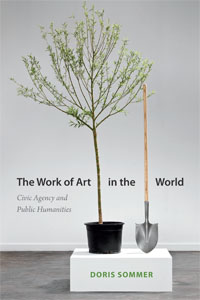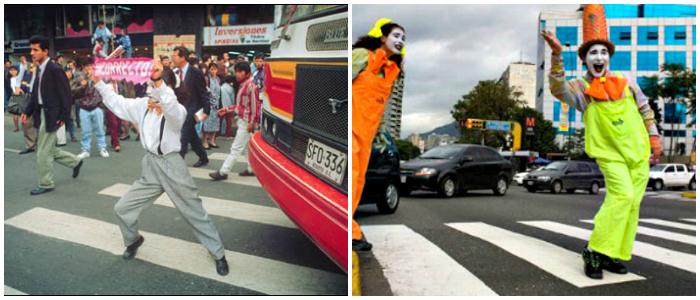 by Anna Upchurch, Impact of Social Sciences: http://blogs.lse.ac.uk/impactofsocialsciences/2014/03/23/the-work-of-art-in-the-world/
by Anna Upchurch, Impact of Social Sciences: http://blogs.lse.ac.uk/impactofsocialsciences/2014/03/23/the-work-of-art-in-the-world/Celebrating art and interpretation that take on social challenges, Doris Sommer looks to steer the humanities back to engagement with the world.
Among the cases that she covers are top-down initiatives of political leaders, such as those launched by Antanas Mockus, former mayor of Bogotá, Colombia, and also bottom-up movements like the Theatre of the Oppressed created by the Brazilian director, writer, and educator Augusto Boal.
This inspiring book is filled with models, sources, and ideas that can be adapted and adopted to inform teaching and research about activist art and creativity, finds Anna Upchurch.
This review originally appeared on LSE Review of Books.
Recent years have seen a number of new books published by senior academics responding to the current budget-cutting tensions that arts and humanities disciplines face in higher education, caused by economic recessions in Western Europe and the United States.
Notable examples include Not for Profit: Why Democracy Needs the Humanities by Martha C. Nussbaum (2010), The Humanities and the Dream of America by Geoffrey Galt Harpham (2011), Blow Up the Humanities by Toby Miller (2012), and The Value of the Humanities by Helen Small (2013).
Stefan Collini’s What are Universities For? (2012) answers the big question expressed in its provocative title and includes a chapter, ‘The Character of the Humanities’.
While each makes a distinctive contribution to the current debate, broadly speaking these books historicize and re-state arguments about the value of arts and humanities subjects, research, and education to contemporary societies.
Doris Sommer’s The Work of Art in the World: Civic Agency and the Public Humanities is a fresh and welcome addition that explores projects from the programme she founded at Harvard University, the Cultural Agents Initiative, within the context of socially engaged art and interpretation.
Sommer is Professor of Romance Languages and Literatures and of African and African American Studies at Harvard and also author of Bilingual Aesthetics: A New Sentimental Education.
Established in 2000, the Cultural Agents Initiative ‘has sought to increase the impact of creative and scholarly practices by identifying artists, educators, and community leaders who have developed socially productive artistic practices, by reflecting on the role of art in building civil society, and by disseminating best practices through workshops and public forums’.
Sommer recalls in the book’s introduction that a motivation to start the programme were very real fears about the future of the humanities in corporatized universities.
The Work of Art in the World looks back over more than a decade of collaboration between artists and academics and ‘takes inspiration from arts projects that merit more sustained reflection than they have gotten. These are creative works on grand and small scales that morph into institutional innovation. Reflecting on them is a humanistic assignment insofar as the humanities teach interpretation of art (to identify points of view, attend to technique, to context, to competing messages, and evaluate aesthetic effects)’ (p. 3).
This aesthetic training by humanists ‘can fulfil a special mission by keeping aesthetics in focus, lingering with students and readers over the charmed moments of freely felt pleasure that enable fresh perceptions and foster new agreements’ (p. 3).
Drawing upon intellectual sources that include Kant, Schiller, Dewey, and Ranciére, among others, Sommer argues that the aesthetic training that fosters individual judgement underpins civic life in democracies.
Her concern is not to teach pessimism and retreat from the world: ‘Teaching despair to young people seemed to me not only tedious but irresponsible compared to making a case for cultural agents’ (p. 6).
And no doubt her students, like mine, are far more interested in her risk-taking cultural agents and models of practice that they can analyse, interpret, and potentially adapt.
The book opens with two chapters that explore these projects and models.
Chapter one, ‘From the Top’, examines government-sponsored creativity in projects as diverse as the troupe of traffic-directing mimes in Bogotá, Colombia, conceived by then-Mayor Antanas Mockus, to the Work Progress Administration’s Federal Art Project in the US from 1935 to 1939 during President Franklin Delano Roosevelt’s New Deal.
The importance of play and pleasure in changing public attitudes was illustrated by the mimes, who drew attention in fun ways to traffic and pedestrian safety, helping to reduce deaths and accidents.
This programme was one of many creative initiatives in the public space in Bogotá that Mockus was invited to Harvard to share in the Cultural Agents programme.
Professional mimes shadowed pedestrians who didn’t follow crossing rules: A pedestrian running across the road would be tracked by a mime who mocked his every move. Mimes also poked fun at reckless drivers. Credit: Harvard University Gazette.
Chapter two, ‘Press Here’, concerns ‘bottom up’ initiatives by artists and cultural agents who are catalysts and organizers.
Sommer recalls the international artistic and political career of Augusto Boal, who developed Forum Theatre and other interactive theatre techniques and games that encouraged ‘spect-actors’ to explore moral and ethical challenges of everyday life.
Like Mockus, Boal was invited to Harvard to lead workshops and teach his techniques to participants and students.
The workshops had ripple effects such as a summer theatre production at the local high school, which led to a Forum Theatre approach to AIDS prevention and treatment for youth in Tanzania, among other offshoots.
Other change-agent projects include an exhibition about ACT UP, the gay rights campaign in the late 1980s and early 1990s in New York that resulted in lower prices and shorter approval times for AIDS treatments.
Chapter four describes ‘Pre-Texts’, a programme in Boston, Mass., that integrates literacy, sustainable arts and materials, and civic values, using the arts to teach literacy and literary criticism to young people ranging in age from kindergarten to graduate studies.
Part of the Cultural Agents Initiative, Pre-Texts trains artists and teachers to facilitate workshops at schools, summer programmes, and other settings, inviting young people to interpret classic literary texts through their own art made from recycled materials.
Few of us have access to the resources that Sommer has at Harvard, but this inspiring book is filled with models, sources, and ideas that can be adapted and adopted to inform teaching and research about activist art and creativity.
Image credit: Mimes, Harvard University Gazette.
Image credit: Humanities Centre University of Alberta Edmonton Alberta Canada, WinterforceMedia (Wikimedia public domain).
—————————————Anna Upchurch is Lecturer in Cultural Industries at the University of Leeds. She specializes in cultural policy and the history of ideas about the arts and humanities in society.
She co-edited Humanities in the Twenty-First Century: Beyond Utility and Markets (2013) with Dr Eleonora Belfiore. Read more reviews by Anna.

No comments:
Post a Comment